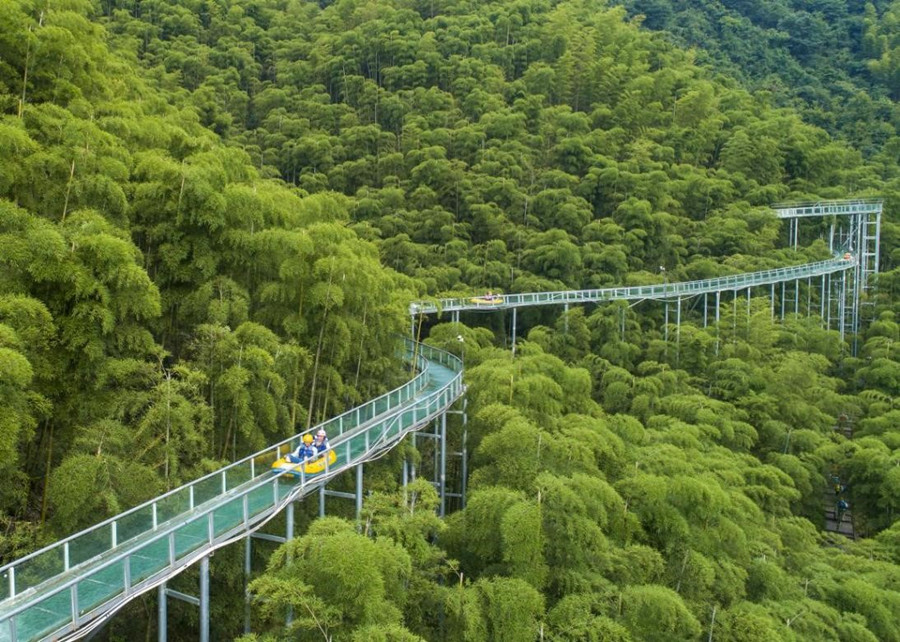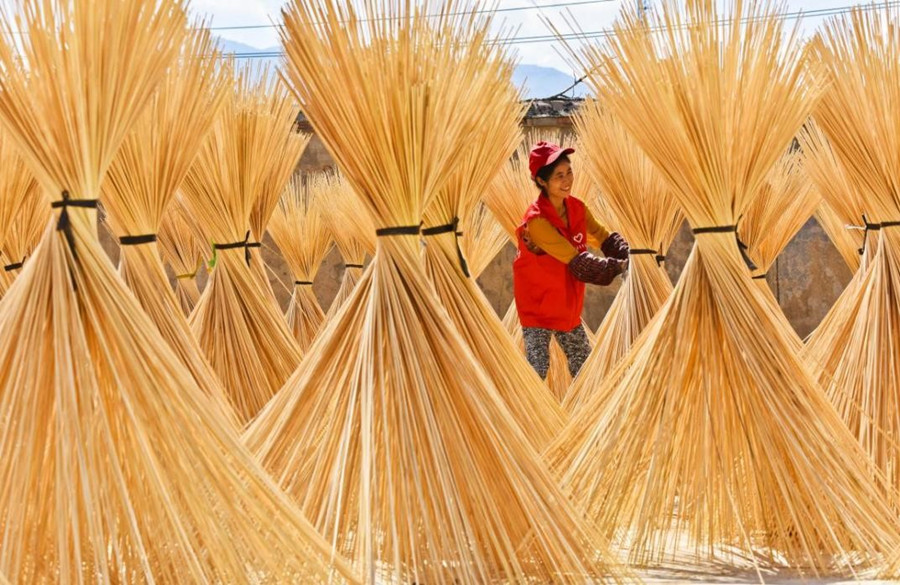China's bamboo industry contributes to global green development
Dubbed as the "kingdom of bamboos," China is home to over 800 of the world's 1,642 known species of bamboos. As of October, 2021, the country had planted over 100 million mu, or 6.67 million hectares of bamboos, with an annual bamboo production of around 40 million tons. However, the number only accounted for about a quarter of the annual allowable cut.

Tourists experience water slide over a bamboo forest in Shangshu township, Anji county, Huzhou, east China's Zhejiang province, July 27, 2022. [People's Daily Online/Xia Pengfei]
Bamboos take about three to five years to get established. They are a valuable renewable natural resource for mankind. Science-based exploitation of bamboos doesn't affect the growth of them, but adjusts their structure and improves their quality, which helps fully tap into the ecological, economic and social benefits of the plants.
The Chinese are a pioneer in the exploitation of bamboos. In China, bamboos are widely made into construction materials and daily necessities, such as tissues, straws, tableware and baseboards of truck beds, which are sold to many countries around the world.
According to statistics, the output of China's bamboo industry surged from around 82.1 billion yuan in 2010 to 321.8 billion yuan in 2020. The number is expected to exceed a trillion yuan by 2035.
Apart from developing its own advantages in the bamboo industry, China is also sharing its technologies and experiences to help other countries with rich bamboo resources get rid of poverty and improve environment.
In Africa, China is offering strong support for the Inter-Africa Bamboo Smallholder Farmers Livelihood Development Programme launched by the International Bamboo and Rattan Organization (INBAR). The country, by offering training courses, is sharing its experiences in the protection, planting, cutting and management of bamboos with local bamboo smallholder farmers in Ghana and other African countries, to help the latter get more involved in the value chain of the bamboo industry.

A villager is sun-drying bamboo splits at a bamboo processing plant in Xinan village, Gaofu township, Zixi county, Fuzhou, east China's Jiangxi province, July 12, 2022. [People's Daily Online/Wu Zhigui]
It is reported that a China-Africa bamboo center is expected to be built in Ethiopia for research and training. It will help Africa better develop its bamboo and rattan industry.
As a biologic material that's widely grown around the world, bamboos enjoy a huge potential in driving global green development," said Lu Wenming, deputy director general of the INBAR, adding that bamboos can be applied in a wide range of fields and almost every part of them can be utilized.
More importantly, bamboo products are in a low-carbon and even carbon-negative condition throughout their lifecycle. Compared with plastic products, bamboo products can maintain a negative carbon footprint. They are totally degradable and thus more environmentally friendly, Lu noted.
Besides, bamboos can advance global green development with their strong capability of carbon fixation. Once bamboos are made into products, they are able to store carbon dioxide for a very long time.
Bamboo winding composites are a biological material independently developed by China. China holds full intellectual property rights to the material. The composites can be used to make water conservancy, municipal and transport utility tunnels.

Photo taken on July 6, 2022 shows an acceptance letter made from thin bamboo slice issued by Zhejiang Agriculture and Forestry University. [People's Daily Online/Chen Shengwei]
Fei Benhua, director general of the INBAR and president of China Bamboo Industry Association, told People's Daily that pipelines made from bamboo winding composites are lighter, more resilient and stronger than iron ones. Besides, they are also degradable, Fei added.
Ten million tons of bamboo winding composites are able to cut 52.23 million tons of carbon dioxide emission if they are used to replace helical welded pipes.
On June 24 this year, the Bamboo as a Substitute for Plastic Initiative proposed by the INBAR was included in the deliverables of the High-level Dialogue on Global Development. It will be jointly promoted by China and the INBAR to reduce plastic pollution, cope with climate change, and advance global green development.
Bamboos are a valuable asset as the world seeks green development. China is gradually becoming a global leader in the management and technological innovation regarding bamboo resources thanks to the prospering Chinese bamboo industry. The country is contributing to the world Chinese "bamboo schemes" that reflect infinite possibilities of a green future.
























